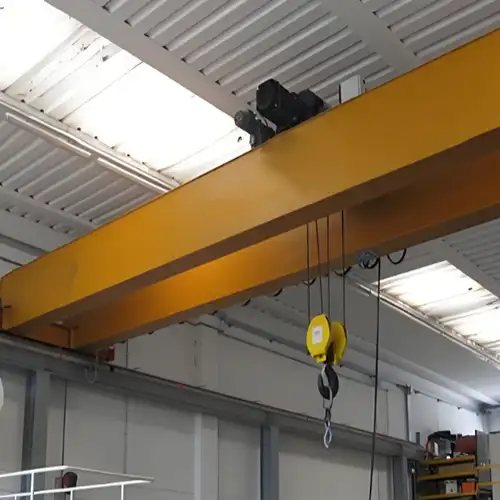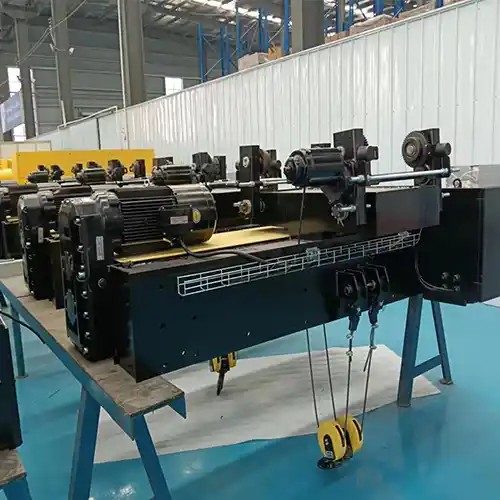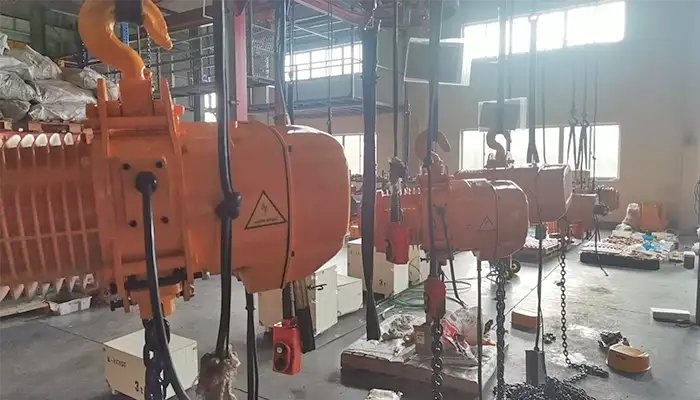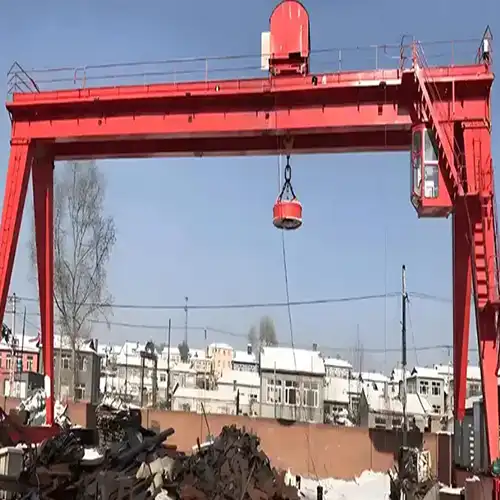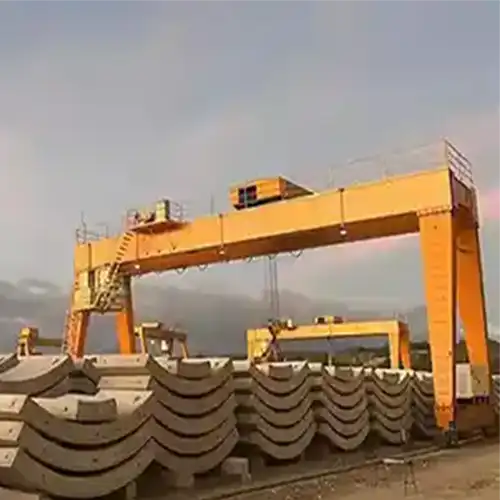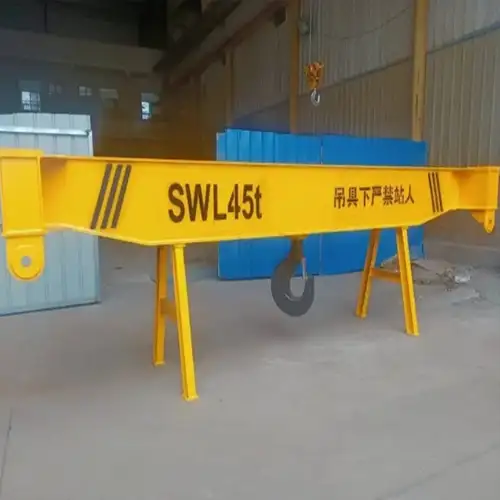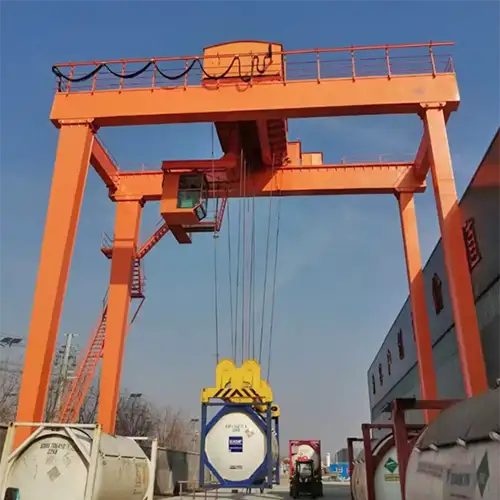How to Obtain a Detailed 10 Ton Overhead Crane Quote
Learn how to request and review a detailed 10-ton overhead crane quote to ensure clarity and precision in specifications and pricing.
Category: 10 Ton Overhead Crane
Your Trusted Overhead Crane Manufacturer & Supplier
How to Obtain a Detailed 10-Ton Overhead Crane Quote
Learn how to request and review a detailed 10-ton overhead crane quote to ensure clarity and precision in specifications and pricing.In the field of industry and construction, efficiency is key. And when it comes to lifting heavy loads with precision and safety, nothing quite matches the capability of a 10 ton overhead crane. But before you dive into making a purchase, it's crucial to obtain a detailed quote. Why? Well, think of it as the blueprint for your investment. It not only helps you understand the costs involved but also ensures that you get exactly what you need. So, in this guide, we'll walk you through the steps to secure that essential quote.
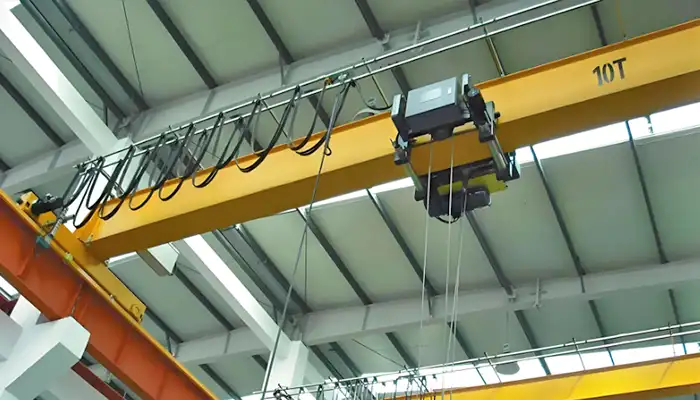
single girder overhead crane 10 ton

double girder overhead crane 10 ton
- Researching Potential Suppliers:Now that you know what you need, it's time to find the right supplier. Look for reputable manufacturers or suppliers known for their quality products and reliable services. Dive into their offerings, checking specifications, warranties, and customer reviews. It's like shopping for the perfect tool - you want something sturdy, dependable, and backed by satisfied customers.
- Providing Detailed Information to Suppliers:Once you've narrowed down your options, it's time to reach out to the suppliers. But before you do, make sure you have all the necessary details at hand. Provide accurate specifications and any special requirements you might have. Clear communication ensures that the suppliers understand exactly what you need, leaving no room for misunderstandings down the line.
- Evaluating Quotes:As the quotes start rolling in, it's time to put on your detective hat. Review each quote carefully, comparing not just the prices but also the value offered. Look for completeness and clarity. After all, you don't want any surprises popping up later. And don't hesitate to ask questions if something isn't clear. Remember, it's your investment - you have every right to ensure you're getting your money's worth.
- Negotiating and Finalizing the Deal:Armed with your knowledge and a stack of quotes, it's time to seal the deal. Negotiate with your preferred suppliers, discussing any modifications or adjustments needed. Once you're satisfied with the terms, finalize the agreement. And don't forget to confirm the delivery and installation timelines. After all, you're not just buying a crane - you're investing in your business's efficiency and productivity.
Obtaining a detailed quote for a 10 ton overhead crane might seem like a daunting task, but it's a crucial step in making the right investment for your business. By understanding your needs, researching potential suppliers, and carefully evaluating quotes, you can ensure that you get a crane that meets your requirements without breaking the bank. So, roll up your sleeves, follow the steps outlined in this guide, and unlock the efficiency that comes with the perfect overhead crane for your operations.
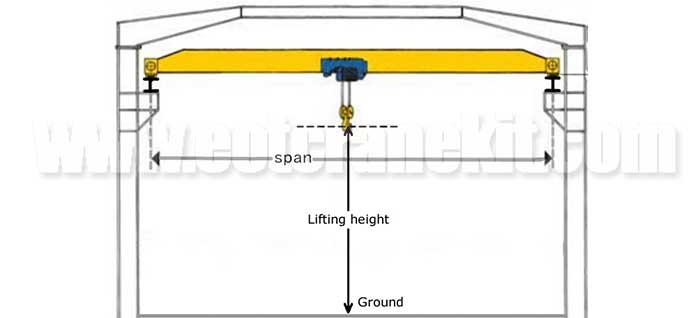
Understanding Your Needs
When it comes to overhead cranes, one size definitely doesn't fit all. That's why the first step is to assess your specific requirements. Consider factors like the weight capacity, span, height requirements, and the environment in which the crane will operate. Are you lifting hefty machinery in a factory or handling materials in a warehouse? Understanding your needs ensures that you get a crane tailored to your operations.
Assessing Specific Requirements
- Weight Capacity: First things first, consider the heaviest load you'll need to lift. Ensuring that the crane's weight capacity comfortably exceeds this figure prevents any risks of overloading and guarantees smooth operations.
- Span and Height Requirements: Measure the distance across which the crane will operate and determine the required lifting height. This ensures that the crane's dimensions align perfectly with your workspace, maximizing efficiency and safety.
- Duty Cycle: Think about how often the crane will be in use and for how long each time. Understanding the duty cycle helps in selecting a crane that can handle the anticipated workload without wearing out prematurely.
- Environmental Factors: Take stock of the environmental conditions in which the crane will operate. Factors like temperature, humidity, and the presence of corrosive substances can influence the choice of materials and coatings for the crane's components, ensuring longevity and reliability.
Determining Special Features or Customization
- Remote Control: Consider whether remote operation would enhance efficiency and safety in your operations. Remote-controlled cranes allow operators to maintain a safe distance while still having precise control over the crane's movements.
- Safety Features: Safety should always be a top priority. Look for features like overload protection, emergency stop buttons, and collision avoidance systems to minimize the risk of accidents and injuries in the workplace.
- Hoist Speed: Evaluate the need for speed in your operations. Opting for a crane with adjustable hoist speed allows you to optimize productivity without compromising safety, especially in scenarios where precision is crucial.
- Automation Integration: Assess the potential for integrating the crane with other automated systems in your facility. Seamless integration with conveyor systems or production lines can streamline material handling processes and improve overall efficiency.
By carefully assessing these specific requirements and considering any special features or customization needed, you lay the foundation for selecting a 10 ton overhead crane that not only meets but exceeds your expectations, setting the stage for increased productivity and success in your operations.
Researching Potential Suppliers
Once you've outlined your requirements, the next step is to find the right supplier who can meet those needs. Here's how you can go about it:

Identifying Reputable Crane Manufacturers or Suppliers
Before diving into the sea of suppliers, it's essential to identify those with a solid reputation for quality products and reliable service. Look for manufacturers or suppliers who have a track record of delivering on their promises and satisfying their customers' needs.
- Research and Background CheckStart by conducting thorough research on potential crane manufacturers or suppliers. Look for companies with established reputations in the industry, including their years of operation, client portfolio, and projects they have completed. Utilize online resources, industry forums, and professional networks to gather information and insights about different manufacturers or suppliers. Pay attention to reviews, ratings, and testimonials from past clients to gauge their satisfaction levels.
- Track Record of Delivering Quality ProductsEvaluate the track record of each manufacturer or supplier in terms of their ability to deliver quality crane products. Look for evidence of successful projects and satisfied customers who have received reliable and durable equipment. Consider factors such as on-time delivery, adherence to specifications, and the overall performance of the crane equipment in real-world applications. A manufacturer or supplier with a proven track record of delivering quality products is more likely to meet your expectations and requirements.
- Commitment to Customer SatisfactionAssess the manufacturer or supplier's commitment to customer satisfaction and service excellence. Look for indicators such as responsive communication, personalized support, and proactive problem-solving. Engage with the manufacturer or supplier directly to discuss your needs and expectations. Pay attention to their level of attentiveness, professionalism, and willingness to address any concerns or questions you may have. A reputable manufacturer or supplier will prioritize your satisfaction and strive to exceed your expectations.
- Certifications and AccreditationsVerify whether the manufacturer or supplier holds relevant certifications and accreditations that demonstrate their adherence to industry standards and best practices. Look for certifications such as ISO 9001 for quality management systems and certifications specific to crane manufacturing and safety standards. Accredited manufacturers or suppliers have undergone rigorous assessments and audits to ensure their products meet stringent quality and safety requirements. Choosing a certified manufacturer or supplier provides added assurance of the reliability and integrity of their products and services.
- References and RecommendationsSeek references and recommendations from industry peers, colleagues, or professional associations when evaluating crane manufacturers or suppliers. Personal referrals from trusted sources can provide valuable insights and firsthand experiences that help inform your decision-making process. Reach out to contacts who have previously worked with the manufacturer or supplier you're considering and inquire about their experiences, including the quality of the products, reliability of the service, and overall satisfaction with the partnership.
By carefully identifying reputable crane manufacturers or suppliers based on these considerations, you can make informed decisions and establish successful partnerships that meet your needs for quality products and reliable service.
Gathering Information on Their Products and Services
- Crane SpecificationsDelve into the specifics of each supplier's crane offerings to ensure they meet your operational requirements. Pay close attention to details such as load capacity, lifting height, span, and any customizable options available. Evaluate whether the supplier offers a range of crane models that can accommodate different project needs and specifications. Consider factors such as the environment in which the crane will be operating, the types of loads to be lifted, and any space constraints that need to be addressed.
- Warranty and SupportAssess the level of support provided by each supplier beyond the initial purchase of the crane equipment. A comprehensive warranty and access to reliable customer support are essential factors to consider. Review the terms and conditions of the warranty, including coverage duration, limitations, and procedures for claiming warranty service. Ensure that the supplier offers timely and responsive support to address any issues or concerns that may arise during the crane's lifespan.
- Customer Reviews and TestimonialsSeek out feedback from previous customers to gain insights into the supplier's reliability, product quality, and level of service. Customer reviews and testimonials provide valuable firsthand accounts of experiences with the supplier. Look for patterns in customer feedback regarding factors such as product performance, durability, ease of installation, and responsiveness of customer support. Positive reviews and testimonials indicate a supplier's commitment to customer satisfaction and the quality of their products and services.
- Safety Features and ComplianceEvaluate the safety features incorporated into the supplier's crane designs to ensure compliance with industry standards and regulations. Safety considerations are paramount when selecting crane equipment to minimize the risk of accidents and injuries in the workplace. Inquire about safety certifications and compliance with relevant standards such as OSHA, ANSI, and ISO. Verify that the supplier conducts regular safety inspections and maintenance to uphold the integrity and reliability of their crane products.
- Customization Options and FlexibilityAssess the supplier's ability to accommodate customization requests and tailor their crane solutions to meet specific project requirements. Look for suppliers who offer flexibility in design, configuration, and installation to address unique operational needs. Discuss customization options with the supplier, including modifications to crane dimensions, configurations, control systems, and safety features. Ensure that the supplier can provide expert guidance and support throughout the customization process to deliver a tailored solution that meets your exact specifications.
By gathering comprehensive information on crane products and services from suppliers based on these considerations, you can make well-informed decisions and select a supplier that aligns with your project requirements and expectations.

Contacting Suppliers for Initial Inquiries and Quotes
Armed with your research, reach out to the selected suppliers for initial inquiries. Be prepared to discuss your specific requirements in detail and ask any questions you may have about their products and services. Request a detailed quote that outlines the costs involved, including any customization or additional services required.
- Preparation and ResearchBefore reaching out to suppliers, ensure that you have thoroughly researched their products, services, and reputation in the industry. Familiarize yourself with their offerings, specifications, and any customization options available. Clarify your specific requirements and objectives for the crane equipment, including load capacity, lifting height, operational environment, and any special features or functionalities needed. This preparation will enable you to communicate your needs effectively during the inquiry process.
- Initiating ContactReach out to the selected suppliers via email, phone, or online contact forms to initiate the inquiry process. Introduce yourself and provide a brief overview of your project or requirements to establish a context for the discussion. Be prepared to engage in a dialogue with the supplier to gather additional information, address any questions or concerns, and explore potential solutions that meet your needs. Maintain a professional and courteous demeanor throughout the communication process to foster a positive relationship with the supplier.
- Detailed DiscussionDuring your initial contact with the supplier, delve into the specifics of your requirements and inquire about their capabilities, product offerings, and customization options. Provide detailed information about your project scope, timeline, and budget constraints to facilitate an accurate assessment and proposal from the supplier. Ask relevant questions about the supplier's experience, manufacturing processes, quality control measures, and warranty policies to gain a comprehensive understanding of their capabilities and commitment to customer satisfaction.
- Requesting a QuoteRequest a detailed quote from the supplier that outlines the costs involved in procuring the crane equipment, including the base price, customization fees, delivery charges, and any additional services or accessories required. Clearly communicate your expectations regarding the scope of the quote, including any specific inclusions or exclusions, terms and conditions, and timelines for delivery and installation. Request clarification on any ambiguous or unclear aspects of the quote to avoid misunderstandings later on.
- Evaluation and ComparisonEvaluate the quotes received from different suppliers based on factors such as price, product features, customization options, warranty coverage, and overall value proposition. Compare the proposals side by side to identify the supplier that offers the best combination of quality, reliability, and affordability. Consider scheduling follow-up discussions or meetings with the shortlisted suppliers to further explore their offerings, address any remaining questions or concerns, and finalize the terms of the agreement. A collaborative approach to the procurement process can help ensure that your needs are fully met and that you make an informed decision that aligns with your project goals.
By following these steps and engaging in proactive communication with suppliers, you can gather the information and insights needed to make informed decisions and secure the right crane equipment for your project requirements.
By conducting thorough research and reaching out to potential suppliers, you set the stage for a successful partnership with a supplier who not only meets but exceeds your expectations, ensuring a smooth and efficient procurement process for your 10 ton overhead crane.
Providing Detailed Information to Suppliers
Now that you've identified potential suppliers, it's time to ensure they have all the necessary information to provide you with an accurate quote. Here's how you can effectively communicate your requirements:
Furnishing Accurate Specifications and Requirements
Be as specific as possible when detailing your crane needs. Provide precise measurements for weight capacity, span, and height requirements. If you have any unique operational conditions, such as high temperatures or corrosive environments, make sure to mention them. The more accurate the information you provide, the better equipped the suppliers will be to tailor their offerings to your needs.
- Detailed Weight Capacity RequirementsProvide precise measurements and specifications for the weight capacity of the crane equipment needed for your operations. Consider factors such as the maximum load weight that the crane will need to lift and maneuver, as well as any variations in load capacity required for different tasks or applications. Account for potential future growth or changes in your operational needs when determining the weight capacity requirements for the crane. It's essential to ensure that the crane can safely handle anticipated loads without exceeding its capacity limits.
- Span and Height RequirementsSpecify the required span and lifting height for the crane to effectively meet your operational requirements. Provide accurate measurements and dimensions for the span of the crane, including the distance between support structures or runway beams. Consider the vertical clearance needed for the crane to operate safely and efficiently within your facility. Factor in any overhead obstacles or obstructions that may impact the crane's lifting height and maneuverability.
- Unique Operational ConditionsIdentify any unique operational conditions or environmental factors that may impact the performance and longevity of the crane equipment. Examples include high temperatures, corrosive environments, or hazardous materials present in the work area. Communicate these specific requirements to the suppliers to ensure that they can recommend suitable crane solutions that are designed to withstand the challenges posed by your operational conditions. This may involve selecting specialized materials, coatings, or design features to enhance the durability and reliability of the crane in harsh or demanding environments.
- Integration with Existing SystemsIf the crane equipment needs to integrate with existing systems or infrastructure within your facility, provide detailed information about compatibility requirements and interface specifications. This may include communication protocols, control systems, or automation features that need to be seamlessly integrated with your existing operations. Collaborate closely with the suppliers to ensure that the proposed crane solutions align with your existing infrastructure and workflows. Clarify any technical specifications or compatibility issues upfront to avoid potential compatibility issues or integration challenges down the line.
- Future Expansion and ScalabilityConsider your future growth and expansion plans when specifying your crane requirements. Provide information about anticipated changes in workload, production volumes, or facility layout that may impact the crane's performance and capacity requirements over time. Discuss scalability options and flexibility with the suppliers to ensure that the proposed crane solutions can accommodate future growth and adapt to evolving operational needs. This may involve selecting modular or customizable crane designs that can be easily expanded or upgraded to meet changing requirements.
By furnishing accurate specifications and requirements to the suppliers, you can ensure that they have a clear understanding of your crane needs and can tailor their offerings accordingly. This proactive approach helps minimize misunderstandings, streamline the procurement process, and ultimately, lead to the selection of crane equipment that meets your specific operational requirements and objectives.
Communicating Any Special Considerations or Preferences
Don't hesitate to communicate any special considerations or preferences you may have. Whether it's a preference for a particular brand or a requirement for specific safety features, make sure to articulate your needs clearly. If there are any customization options available, such as color choices or additional accessories, let the suppliers know. Your input ensures that the final product aligns perfectly with your expectations.
- Brand Preferences and ReputationIf you have a preference for a particular brand based on past experiences, reputation, or industry recognition, communicate this to the suppliers. Provide reasoning behind your preference, such as reliability, durability, or specific features offered by the brand. Discuss your brand preference with the suppliers and inquire about their offerings from the desired brand. Seek assurance that the selected brand aligns with your expectations and requirements for quality, performance, and reliability.
- Specific Safety RequirementsIdentify any specific safety features or considerations that are essential for your operations. This could include features such as overload protection, emergency stop mechanisms, anti-collision systems, or remote monitoring capabilities. Communicate your safety requirements clearly to the suppliers and inquire about the availability of these features in their crane offerings. Ensure that the selected crane equipment meets or exceeds industry safety standards and regulations to mitigate risks and ensure the safety of personnel and assets.
- Customization OptionsIf customization options are available for the crane equipment, such as color choices, control system configurations, or additional accessories, communicate your preferences to the suppliers. Specify any customization requirements or preferences upfront to ensure that the final product aligns with your aesthetic and functional preferences. Discuss customization options with the suppliers and inquire about the feasibility, cost implications, and lead times associated with implementing your preferences. Collaborate closely with the suppliers to explore customization possibilities that meet your needs while maintaining the integrity and performance of the crane equipment.
- Operational Preferences and Workflow ConsiderationsConsider any specific operational preferences or workflow considerations that may impact the selection of crane equipment. This could include factors such as operational speed, maneuverability, ease of maintenance, or compatibility with existing systems and processes. Communicate your operational preferences and workflow considerations to the suppliers to ensure that the proposed crane solutions align with your operational requirements and objectives. Provide detailed information about your operational environment, tasks, and workflows to facilitate an accurate assessment and proposal from the suppliers.
- Budget Constraints and Value PropositionIf you have specific budget constraints or financial considerations, communicate these to the suppliers upfront. Discuss your budget limitations and expectations regarding the value proposition offered by the crane equipment, including factors such as upfront costs, long-term maintenance expenses, and return on investment. Collaborate with the suppliers to explore cost-effective solutions that meet your budget constraints while delivering the desired performance, reliability, and functionality. Seek transparency and clarity regarding pricing, fees, and any additional costs associated with customization or special considerations to avoid unexpected expenses later on.
By communicating any special considerations or preferences to the suppliers, you can ensure that they have a clear understanding of your needs and expectations. This collaborative approach fosters open communication, facilitates alignment between your requirements and the supplier's offerings, and ultimately, leads to the selection of crane equipment that meets your specific preferences and objectives.
Requesting Clarification on Any Unclear Points
If there are any aspects of the supplier's proposal that are unclear or ambiguous, don't hesitate to seek clarification. Whether it's regarding pricing, warranty terms, or technical specifications, asking questions ensures that you have a complete understanding of what's being offered. Clear communication helps avoid misunderstandings and ensures that both parties are on the same page throughout the procurement process.
- Pricing and Cost StructureIf there are any uncertainties or ambiguities regarding the pricing or cost structure outlined in the supplier's proposal, request clarification to ensure transparency and accuracy. Seek clarification on any additional fees, taxes, or charges that may apply to the crane equipment or related services. Inquire about the breakdown of costs and the basis for pricing calculations to understand how the total cost is determined.
- Warranty Terms and CoverageReview the warranty terms and coverage provided by the supplier and seek clarification on any unclear points or limitations. Inquire about the duration of the warranty, coverage for parts and labor, and any conditions or exclusions that may apply. Ask questions about the process for filing warranty claims, turnaround times for repairs or replacements, and any costs associated with warranty service. Ensure that you have a clear understanding of your rights and obligations under the warranty agreement.
- Technical Specifications and Performance GuaranteesIf there are technical specifications or performance guarantees outlined in the supplier's proposal that are unclear or ambiguous, request clarification to ensure that you fully understand the capabilities and limitations of the crane equipment. Seek detailed explanations of key technical parameters, such as load capacity, lifting height, operating speeds, and safety features. Inquire about any performance guarantees or assurances provided by the supplier and the mechanisms for verifying compliance with specified requirements.
- Delivery and Lead TimesClarify the delivery and lead times associated with the procurement and installation of the crane equipment. Inquire about the estimated timeframe for manufacturing, shipping, and onsite installation to ensure alignment with your project schedule and deadlines. Ask questions about the supplier's production capacity, inventory levels, and logistics arrangements to assess their ability to meet your timeline requirements. Discuss any potential delays or contingencies that may impact the delivery schedule and explore mitigation measures to minimize disruptions to your operations.
- Terms and Conditions of the AgreementReview the terms and conditions of the agreement proposed by the supplier and seek clarification on any provisions that are unclear or require further explanation. Inquire about your rights and obligations under the agreement, as well as any penalties or liabilities that may apply in case of non-compliance. Ask questions about payment terms, contractual obligations, dispute resolution mechanisms, and termination clauses to ensure that you fully understand the terms of the agreement before proceeding. Seek legal or professional advice if necessary to clarify any legal or contractual implications.
By requesting clarification on any unclear points in the supplier's proposal, you can ensure that you have a complete understanding of the terms, conditions, and specifications involved in the procurement process. Clear communication helps avoid misunderstandings, mitigate risks, and foster a collaborative and transparent relationship with the supplier throughout the procurement and implementation phases.
By providing detailed information to suppliers, communicating any special considerations or preferences, and seeking clarification on any unclear points, you lay the groundwork for a productive collaboration that results in a tailored solution that meets your needs precisely.
Evaluating Quotes
Once you've received quotes from different suppliers, it's time to roll up your sleeves and start evaluating them. Here's how to ensure you're making an informed decision:
Reviewing the Provided Quotes for Completeness and Accuracy
Take a close look at each quote to ensure it includes all the necessary details. Check that the specifications match your requirements and that there are no omissions or discrepancies. Make sure any special considerations or customization requests are clearly reflected in the quote. Accuracy and completeness are essential for avoiding surprises later on.
- Specification AlignmentCarefully compare the specifications outlined in each quote with your requirements to ensure they align accurately. Verify that essential details such as weight capacity, span, lifting height, and safety features match your operational needs. Look for any discrepancies or inconsistencies between the quoted specifications and your stated requirements. Address any mismatches or deviations with the supplier to ensure that the proposed crane equipment meets your expectations and objectives.
- Inclusion of Customization RequestsCheck that any special considerations or customization requests you communicated to the supplier are clearly reflected in the quote. Ensure that customization options such as color choices, control system configurations, or additional accessories are accurately documented. Review the pricing and terms associated with customization requests to confirm that they align with your budget and expectations. Seek clarification from the supplier if there are any ambiguities or uncertainties regarding the inclusion of customization options in the quote.
- Scope of Services and DeliverablesEvaluate the scope of services and deliverables outlined in each quote to ensure that all necessary components and activities are included. Verify that the quote covers not only the cost of the crane equipment but also any additional services such as delivery, installation, training, and ongoing support. Check for any exclusions or limitations that may impact the completeness of the quote. Inquire about any optional or add-on services that are available and assess their relevance to your project requirements.
- Accuracy of Pricing and CostsScrutinize the pricing and cost breakdown provided in each quote to ensure accuracy and transparency. Verify that all costs, fees, taxes, and surcharges are clearly itemized and explained. Review the basis for pricing calculations and inquire about any assumptions or variables that may affect the total cost. Seek clarification from the supplier regarding any unexpected or unexplained charges to avoid surprises later on.
- Terms and ConditionsRead through the terms and conditions outlined in each quote to understand the contractual obligations and responsibilities involved. Pay attention to factors such as payment terms, warranty provisions, delivery timelines, and dispute resolution mechanisms. Clarify any ambiguous or unclear terms with the supplier to ensure that you fully understand your rights and obligations under the proposed agreement. Seek legal or professional advice if necessary to interpret complex or unfamiliar contractual provisions.
By thoroughly reviewing the provided quotes for completeness and accuracy, you can ensure that you have a clear understanding of the proposed terms, conditions, and specifications. This diligent approach helps mitigate risks, avoid misunderstandings, and lay the groundwork for a successful procurement process and partnership with the supplier.
Comparing Pricing and Value Offered by Different Suppliers
While price is undoubtedly a crucial factor, it's essential to look beyond the numbers. Consider the overall value offered by each supplier, taking into account factors such as product quality, warranty coverage, and customer support. Sometimes, a slightly higher upfront cost can translate into long-term savings if it means investing in a more reliable and durable product.
- Product Quality and ReliabilityEvaluate the quality and reliability of the crane equipment offered by each supplier as a primary factor in determining value. Consider factors such as the reputation of the manufacturer, the materials and components used in the construction of the crane, and the adherence to industry standards and regulations. Look for evidence of product quality and reliability through customer reviews, testimonials, and performance data. A higher-quality crane may command a slightly higher upfront cost but can result in long-term savings by reducing maintenance costs, downtime, and the risk of equipment failure.
- Warranty Coverage and SupportAssess the warranty coverage and support provided by each supplier as an essential component of value. Consider the duration of the warranty, coverage for parts and labor, and any additional services included, such as maintenance and technical support. Compare the warranty terms and conditions offered by different suppliers to ensure that you receive adequate protection and support for the crane equipment throughout its lifespan. A comprehensive warranty and reliable customer support can provide peace of mind and help minimize the total cost of ownership over time.
- Customer Support and ServiceConsider the level of customer support and service offered by each supplier as a critical factor in determining overall value. Evaluate factors such as responsiveness, expertise, and availability of support channels, such as phone, email, and onsite assistance. Engage with the suppliers directly to assess their commitment to customer satisfaction and their willingness to address any concerns or issues that may arise during the procurement, installation, or operation of the crane equipment. A supplier that provides proactive and reliable customer support adds significant value by ensuring a positive experience and minimizing disruptions to your operations.
- Total Cost of OwnershipTake a holistic view of the total cost of ownership associated with each supplier's crane equipment to accurately assess value. Consider not only the upfront purchase price but also ongoing costs such as maintenance, repairs, and energy consumption. Factor in the expected lifespan of the crane equipment, maintenance requirements, and potential savings from reduced downtime and increased productivity when comparing the total cost of ownership across different suppliers. A higher initial investment in a more reliable and durable crane may yield greater long-term savings and value.
- Long-Term Benefits and ROIConsider the long-term benefits and return on investment (ROI) associated with each supplier's crane equipment when evaluating value. Assess factors such as productivity improvements, safety enhancements, and operational efficiencies gained from investing in higher-quality equipment. Look beyond the immediate cost savings and consider the potential impact of investing in a more reliable and durable crane on your overall business performance and competitiveness. A supplier that offers superior value through higher-quality products and comprehensive support services can contribute to long-term success and profitability.
By comparing pricing and value offered by different suppliers based on these factors, you can make a more informed decision that aligns with your budget, requirements, and objectives. This comprehensive approach helps ensure that you select a supplier that not only offers competitive pricing but also delivers superior value and support for your crane equipment needs.
Assessing the Level of Detail Provided in the Quotes
Pay attention to the level of detail provided in each quote. A comprehensive quote demonstrates that the supplier has taken the time to understand your needs and has carefully considered all relevant factors. Look for detailed breakdowns of costs, including any optional extras or customization fees. A transparent and detailed quote instills confidence in the supplier's professionalism and integrity.
- Scope of Work and DeliverablesEvaluate the level of detail regarding the scope of work and deliverables outlined in each quote. Look for comprehensive descriptions of the crane equipment and associated services, including specifications, quantities, and any optional extras or customization options. Assess whether the quote addresses all aspects of your project requirements and expectations, including delivery, installation, training, and ongoing support. A detailed breakdown of the scope of work demonstrates that the supplier has a clear understanding of your needs and is committed to delivering a complete solution.
- Itemized Cost BreakdownScrutinize the itemized cost breakdown provided in each quote to ensure transparency and accuracy. Look for detailed explanations of each cost component, including the base price of the crane equipment, taxes, fees, and any additional charges. Evaluate whether the quote includes a clear breakdown of optional extras or customization fees, allowing you to make informed decisions about the inclusion of additional features or services. Transparency in pricing instills confidence in the supplier's professionalism and integrity.
- Customization Options and FeesAssess the level of detail regarding customization options and associated fees included in each quote. Look for clear descriptions of customization features, such as color choices, control system configurations, or additional accessories. Verify that the quote provides transparent pricing for customization options, including any additional fees or surcharges that may apply. Ensure that the supplier has accurately captured your customization preferences and reflected them in the quote.
- Terms and ConditionsReview the terms and conditions outlined in each quote to ensure clarity and consistency. Pay attention to factors such as payment terms, delivery timelines, warranty provisions, and dispute resolution mechanisms. Evaluate whether the quote includes a clear explanation of your rights and obligations under the proposed agreement, as well as any relevant contractual terms and conditions. Seek clarification from the supplier regarding any ambiguous or unclear provisions to avoid misunderstandings later on.
- Professionalism and Attention to DetailConsider the overall professionalism and attention to detail demonstrated by each supplier in preparing the quote. Look for signs of thoroughness, accuracy, and responsiveness in addressing your specific requirements and preferences. Assess whether the supplier has taken the time to understand your needs and has provided thoughtful recommendations and solutions tailored to your project. A detailed and well-presented quote reflects the supplier's commitment to professionalism and customer satisfaction.
By assessing the level of detail provided in the quotes, you can gain valuable insights into the supplier's professionalism, responsiveness, and attention to detail. A comprehensive and transparent quote instills confidence in the supplier's ability to deliver a complete solution that meets your needs and expectations.
Seeking Clarification on Any Discrepancies or Uncertainties
If there are any discrepancies or uncertainties in the quotes, don't hesitate to reach out to the suppliers for clarification. Whether it's a question about a particular specification or a discrepancy in pricing, clear communication is key to resolving any issues promptly. Addressing any concerns upfront ensures that there are no misunderstandings later on and helps you make an informed decision.
- Specification ClarificationIf you encounter any discrepancies or uncertainties regarding the specifications outlined in the quotes, reach out to the suppliers for clarification. Request detailed explanations of any technical terms or parameters that are unclear or ambiguous. Seek clarification on specific aspects of the crane equipment, such as load capacity, lifting height, span, and safety features. Ensure that the specifications align with your operational requirements and expectations.
- Pricing DiscrepanciesIf you identify any discrepancies or inconsistencies in the pricing provided in the quotes, promptly contact the suppliers to seek clarification. Inquire about the basis for pricing calculations and any factors that may have influenced the quoted costs. Request itemized breakdowns of the pricing components to understand how the total cost was determined. Address any unexpected or unexplained charges to ensure transparency and accuracy in the pricing.
- Scope of Work ConfirmationConfirm the scope of work outlined in the quotes to ensure that all necessary components and services are included. Seek clarification on any uncertainties or omissions regarding the deliverables, timelines, or responsibilities outlined in the quote. Discuss any additional services or optional extras that may not have been clearly addressed in the initial quote. Clarify whether these items can be included and obtain updated pricing and terms if necessary.
- Terms and Conditions ClarificationReview the terms and conditions outlined in the quotes and seek clarification on any provisions that are unclear or require further explanation. Inquire about your rights and obligations under the proposed agreement, as well as any potential risks or liabilities. Address any uncertainties regarding payment terms, warranty provisions, delivery timelines, and dispute resolution mechanisms. Seek clarification from the suppliers to ensure that you fully understand the terms of the agreement and can make an informed decision.
- Timely CommunicationMaintain open and proactive communication with the suppliers to address any discrepancies or uncertainties promptly. Reach out to the suppliers as soon as possible upon identifying any issues to avoid delays in the procurement process. Clearly articulate your concerns and questions to the suppliers and provide them with the necessary information and context to facilitate a prompt and accurate response. Be receptive to feedback and be prepared to collaborate with the suppliers to find mutually satisfactory solutions.
By seeking clarification on any discrepancies or uncertainties in the quotes, you can ensure that you have a clear understanding of the terms, conditions, and specifications involved in the procurement process. Clear communication helps avoid misunderstandings, resolve issues promptly, and lay the groundwork for a successful partnership with the suppliers.
By carefully evaluating the quotes provided by different suppliers, you can identify the best option that offers the right balance of price, value, and quality. Don't rush the decision-making process; take the time to thoroughly review each quote and seek clarification on any areas of uncertainty. Ultimately, choosing the right supplier sets the stage for a successful procurement process and ensures that you get the best possible crane for your needs.
Negotiating and Finalizing the Deal
Now that you've narrowed down your options and evaluated the quotes, it's time to seal the deal with your preferred supplier. Here's how to navigate the negotiation and finalization process:
Initiating Negotiations with Preferred Suppliers
Reach out to your preferred suppliers to initiate negotiations. Express your interest in their proposal and highlight any areas where you see potential for collaboration or improvement. Remember, negotiation is a two-way street, so be open to finding mutually beneficial solutions.
- Expression of InterestBegin by reaching out to your preferred suppliers to express your interest in their proposal. Acknowledge the strengths of their offerings and highlight any aspects that resonate with your project requirements and objectives. Clearly communicate your intention to explore potential collaboration and establish a mutually beneficial partnership. Express your eagerness to discuss the details further and explore opportunities for customization or optimization.
- Identification of Areas for ImprovementReview the proposals provided by your preferred suppliers and identify areas where you see potential for improvement or optimization. This could include pricing adjustments, additional services or features, or modifications to the scope of work. Prioritize the key areas where you believe negotiation may lead to enhanced value or alignment with your project goals. Prepare specific points for discussion and be ready to articulate your rationale and objectives during the negotiation process.
- Open CommunicationApproach the negotiation process with an open and collaborative mindset. Foster open communication with the suppliers and encourage them to share their perspectives, insights, and recommendations. Create a supportive environment where both parties feel comfortable discussing their needs, concerns, and priorities. Listen actively to the suppliers' input and be receptive to their suggestions for enhancing the proposed solution.
- Mutually Beneficial SolutionsKeep in mind that negotiation is a two-way street, and the goal is to find mutually beneficial solutions that address the needs and interests of both parties. Be flexible and willing to compromise where necessary to reach a favorable outcome for all parties involved. Look for opportunities to leverage your respective strengths and resources to create value and drive innovation. Explore creative solutions that optimize the value proposition for both sides while maintaining a fair and equitable balance of interests.
- Clear Communication of ExpectationsClearly communicate your expectations and priorities to the suppliers during the negotiation process. Articulate your desired outcomes, timelines, and constraints to ensure alignment and facilitate productive discussions. Be transparent about any non-negotiable requirements or constraints that may impact the negotiation process. Establish clear boundaries and parameters to guide the negotiation and prevent misunderstandings or misalignment of expectations.
- Follow-Up and DocumentationFollow up with the suppliers after each negotiation session to summarize key points of agreement and clarify any outstanding issues or action items. Document the outcomes of the negotiations and confirm the next steps and timelines with all parties involved. Maintain ongoing communication with the suppliers throughout the negotiation process to ensure progress and address any emerging issues or concerns promptly. Stay proactive and engaged to drive the negotiation towards a successful conclusion.
By initiating negotiations with your preferred suppliers in a constructive and collaborative manner, you can create opportunities to enhance the value proposition and align the proposed solution more closely with your project requirements and objectives. Effective negotiation relies on clear communication, flexibility, and a commitment to finding mutually beneficial solutions that lay the foundation for a successful partnership.
Discussing Potential Modifications or Adjustments to the Quote
During the negotiation process, discuss any potential modifications or adjustments to the quote that could better align with your needs or budget. Whether it's negotiating on pricing, requesting additional features, or adjusting delivery timelines, clear communication is key. Don't hesitate to ask for what you need to ensure that the final proposal meets your expectations.
- Negotiating on PricingEngage in open and transparent discussions with the supplier regarding pricing to explore opportunities for negotiation. Assess the competitiveness of the proposed pricing against market benchmarks and your budget constraints. Propose alternative pricing structures, such as volume discounts, payment terms, or bundling of services, to create value and reduce costs without compromising on quality. Be prepared to justify your pricing requests with supporting rationale and market data.
- Requesting Additional Features or ServicesIdentify any additional features or services that would enhance the value proposition of the proposed solution and align more closely with your needs. Discuss these requirements with the supplier and explore options for incorporating them into the quote. Be specific about the additional features or services you're requesting and provide clear reasoning for their inclusion. Consider the potential benefits and trade-offs of each request to ensure that they align with your project objectives and budget constraints.
- Adjusting Delivery TimelinesEvaluate the proposed delivery timelines outlined in the quote and assess their alignment with your project schedule and deadlines. Discuss any concerns or constraints regarding delivery timelines with the supplier and explore options for adjustments. Propose alternative delivery schedules or expedited shipping options to accommodate your timeline requirements while minimizing disruptions to your project. Collaborate with the supplier to find mutually agreeable solutions that balance speed and cost-effectiveness.
- Clarifying Terms and ConditionsReview the terms and conditions outlined in the quote and seek clarification on any provisions that may require modification or adjustment. Discuss any concerns or preferences regarding payment terms, warranty coverage, or contractual obligations with the supplier. Negotiate changes to the terms and conditions as needed to address your specific requirements and mitigate any potential risks or concerns. Ensure that the final proposal reflects mutually agreed-upon terms that are fair and equitable for both parties.
- Documenting AgreementsDocument any modifications or adjustments agreed upon during the negotiation process to ensure clarity and accountability. Summarize key points of agreement and confirm them in writing to avoid misunderstandings or disputes later on. Review the revised quote with the supplier to ensure that it accurately reflects the negotiated terms and conditions. Confirm the final proposal with all parties involved before proceeding to finalize the agreement.
By discussing potential modifications or adjustments to the quote during the negotiation process, you can tailor the proposal to better meet your needs and expectations while fostering a collaborative and productive relationship with the supplier. Clear communication, flexibility, and a willingness to find mutually beneficial solutions are essential for achieving a successful outcome during negotiations.
Finalizing the Terms and Conditions of the Purchase Agreement
Once you've reached an agreement with your preferred supplier, it's time to finalize the terms and conditions of the purchase agreement. Review the contract carefully to ensure that all agreed-upon terms are accurately reflected. Pay close attention to details such as payment terms, warranty coverage, and any additional services included. If there are any areas of ambiguity, seek clarification before signing on the dotted line.
- Reviewing the ContractCarefully review the purchase agreement to ensure that all agreed-upon terms and conditions are accurately reflected. Pay close attention to details such as pricing, payment terms, delivery schedules, warranty coverage, and any additional services or provisions. Compare the terms outlined in the contract with the negotiated agreements reached during the negotiation process. Ensure that there are no discrepancies or deviations from the agreed-upon terms.
- Clarifying Ambiguous PointsIdentify any areas of ambiguity or uncertainty in the purchase agreement and seek clarification from the supplier. If there are terms or provisions that are unclear or open to interpretation, request clarification to ensure mutual understanding and agreement. Address any outstanding questions or concerns with the supplier before proceeding to finalize the agreement. Clear communication is essential to avoid misunderstandings and ensure that both parties are fully aligned.
- Confirming Key DetailsConfirm key details such as the scope of work, specifications of the crane equipment, delivery timelines, and payment terms. Ensure that all necessary information is accurately documented in the purchase agreement to prevent any potential disputes or disagreements later on. Verify that any customization options or special requests are clearly outlined in the contract, along with associated costs and delivery schedules. Confirm that the agreed-upon pricing and terms are consistent with your expectations and requirements.
- Negotiating Changes, if NecessaryIf you identify any discrepancies or discrepancies in the purchase agreement that were not addressed during the negotiation process, negotiate changes with the supplier as needed. Discuss any proposed amendments or modifications to the contract and seek mutual agreement on the revised terms. Be prepared to compromise and find mutually acceptable solutions to any outstanding issues or concerns. Maintain open communication with the supplier to facilitate productive negotiations and reach a final agreement that satisfies both parties.
- Signing the AgreementOnce all terms and conditions have been finalized and agreed upon by both parties, sign the purchase agreement. Ensure that all relevant stakeholders have reviewed and approved the contract before signing on the dotted line. Retain copies of the signed agreement for your records and provide copies to the supplier as necessary. Confirm the effective date of the contract and any additional steps required to initiate the procurement process, such as issuing a purchase order or making an initial payment.
By finalizing the terms and conditions of the purchase agreement in a thorough and systematic manner, you can ensure that both parties have a clear understanding of their rights and obligations. Clear communication, attention to detail, and a collaborative approach are key to achieving a successful outcome and laying the foundation for a productive and mutually beneficial partnership with the supplier.
Confirming Delivery and Installation Timelines
Before finalizing the deal, confirm the delivery and installation timelines with the supplier. Ensure that they align with your project schedule and operational needs. Clarify any logistical details, such as site preparation requirements or access restrictions, to facilitate a smooth delivery and installation process. Clear communication and proactive planning help minimize disruptions and ensure that the crane is up and running when you need it.
- Aligning with Project ScheduleReview the proposed delivery and installation timelines provided by the supplier and ensure that they align with your project schedule and operational needs. Consider factors such as project milestones, deadlines, and dependencies when confirming the timelines. Communicate any schedule constraints or priorities to the supplier and discuss potential adjustments or accommodations to ensure timely delivery and installation of the crane equipment.
- Clarifying Logistical DetailsClarify any logistical details related to the delivery and installation process to facilitate a smooth and efficient operation. Discuss requirements such as site preparation, access restrictions, and any special considerations that may impact the delivery and installation timelines. Coordinate with the supplier to address any logistical challenges or constraints proactively and develop a plan to mitigate potential risks and minimize disruptions to your operations.
- Site Assessment and PreparationConduct a site assessment to evaluate the readiness of the installation site and identify any potential obstacles or challenges that may need to be addressed before the crane can be installed. Ensure that the site meets the necessary requirements and specifications for safe and effective installation. Collaborate with the supplier to develop a site preparation plan that outlines the necessary steps and responsibilities for preparing the installation site. Clarify any site-specific requirements or considerations with the supplier to ensure that the installation process proceeds smoothly.
- Confirming Delivery and Installation ProceduresConfirm the delivery and installation procedures with the supplier to ensure that both parties are aligned on the logistics and expectations. Discuss details such as shipping methods, handling procedures, and installation protocols to ensure a seamless transition from delivery to installation. Review the supplier's proposed delivery and installation plan and provide feedback or clarification as needed. Address any questions or concerns regarding the process to ensure that both parties have a clear understanding of their roles and responsibilities.
- Establishing Communication ChannelsEstablish clear communication channels with the supplier to facilitate ongoing coordination and updates throughout the delivery and installation process. Designate key points of contact on both sides to ensure efficient communication and resolution of any issues or concerns that may arise. Maintain regular communication with the supplier to track progress, address any unforeseen challenges, and ensure that the delivery and installation timelines are adhered to. Keep all stakeholders informed and updated on the status of the project to minimize disruptions and delays.
By confirming delivery and installation timelines with the supplier in advance and addressing any logistical details or concerns proactively, you can help ensure a smooth and successful delivery and installation process. Clear communication, proactive planning, and collaboration with the supplier are essential for minimizing disruptions and ensuring that the crane equipment is installed and operational when you need it.
Conclusion
In the field of heavy machinery, every investment counts. And when it comes to acquiring a 10 ton overhead crane, obtaining a detailed quote is not just a box to tick—it's a critical step towards ensuring success in your operations.
Importance of a Detailed Quote
A detailed quote serves as the roadmap to your investment. It provides clarity on costs, specifications, and terms, ensuring that both parties are on the same page. By obtaining a detailed quote, you mitigate risks, avoid surprises, and set the stage for a successful procurement process.
Understanding Your Needs: Assess your specific requirements, including weight capacity, span, height, duty cycle, and environmental factors.
Researching Potential Suppliers: Identify reputable manufacturers, gather information on their products and services, and contact suppliers for quotes.
Providing Detailed Information to Suppliers: Furnish accurate specifications, communicate any special considerations, and request clarification on unclear points.
Evaluating Quotes: Review quotes for completeness and accuracy, compare pricing and value, assess the level of detail, and seek clarification on any discrepancies.
Negotiating and Finalizing the Deal: Initiate negotiations with preferred suppliers, discuss potential modifications to the quote, finalize the purchase agreement terms, and confirm delivery and installation timelines.
Armed with the knowledge and insights gained from this process, proceed with confidence in selecting the right supplier and crane for your operations. Trust in the thoroughness of your research, the clarity of your communication, and the diligence of your negotiation. With the right supplier and crane by your side, you're poised for success in achieving your operational goals and maximizing efficiency.
In closing, securing a detailed quote for your 10 ton overhead crane isn't just about ticking boxes—it's about setting the stage for success. So, go forth with confidence, knowing that you've laid a solid foundation for a partnership that will propel your business forward.
Main Projects
Related Products

Latest project
32/5 Ton Overhead Crane Sale in India: Case Study
Free consultation to Confirm Parameters & Specifications and Get
Latest Crane Price & Crane Rate.
- Types of overhead cranes : _______?
- Optional: Overhead travelling crane, goliath gantry crane,Slewing jib crane, Single girder or double girder crane,small portable crane or kbk crane, etc.
- Capacity of overhead crane: _______?
- Optional: 0.25ton, 0.5 ton, 1 ton, 2 ton, 3ton, 5 ton, 10 ton,15ton, 20ton, 25 ton, 30ton,35ton, up to 550ton, etc.
- Crane span & lifting height : _______?
- Crane travelling length : _____?
- Control of overhead crane:_______?
- Optional: pendant/ remote/cabin control
- Voltage supply of overhead crane:_____?
- Eg,: 380V50/60HZ,3Phase or others,etc.
- Application/usage of crane:_______?
- Eg,: Steel mill, ,injection mold, cement,stone, concrete,granite, general manufacturing, etc.
Just leave a message via the contact form and our hoist and crane engineer will contact you with in 24working hours.
Get In Touch
